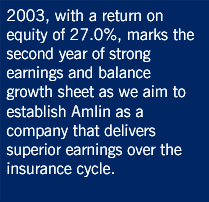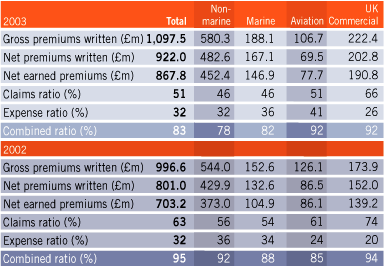|
|
 |
|
|
 |
|
|
 |
 |
 |
|
PERFORMANCE
Underwriting performance
The record £83.3 million of after tax profits achieved in 2003
is attributable to the strong earnings momentum established
in 2002, continued growth in income with prices remaining at
excellent levels, and a relatively low frequency of major claims.
The growth in gross premium written of 31% reflects increased
market share arising from a combination of targeted growth, a flight
to quality as brokers and insureds sought out stability and security,
and the increase in our share of Syndicate 2001ís underwriting.
Net premiums written increased by 37% to £787.6 million, with
the Company maintaining the broad structure of its reinsurance
protection while increasing the retained risk to reflect growth
in the size of the business. 16% of gross income was ceded
compared to 20% in 2002.
Net earned premiums were up 39% to £684.7 million, with 4%,
43% and 53% of it written in respectively 2001, 2002 and 2003
underwriting years, a similar pattern to prior years.
The overall combined ratio improved 12 points to 83%, reflecting
a combination of excellent pricing, tighter terms and a low
incidence of large claims. Claims experience on premiums earned
in prior years was better than anticipated at the last year end,
reflecting our conservative approach to reserving, and the
improvement contributed £24.5 million to the result.
The following divisional analysis provides comparison as if we
owned 100% of the business. This means that comparative
performance is not distorted by changing levels of Amlinís
ownership of Syndicate 2001.

Non-marine
The business written is a blend of classes exposed to catastrophic
or large loss events, which by their nature are volatile, and
attritional property and casualty classes which are more predictable.
The division remains US focussed although the international
exposure of risks written has been increasing particularly in the
property and property reinsurance classes.
During 2003 rating increases in most property related classes
levelled off following the sharp increases achieved in 2002. For
casualty, business rate improvements averaging 23% on renewals
were achieved as this area of the market continued to re-appraise
rating requirements following five years of poor performance.
In this environment the division continued to expand increasing
net written premiums by 12%.
Against this backdrop, the anticipated margins were expected to
be strong and this, coupled with another year of very low claims
incidence from catastrophes, has produced an excellent combined
ratio of 78%.
Marine
Our marine business is also a blend of volatile classes, such
as energy and war, combined with more attritional classes, such
as cargo and yacht.
During 2003 the rate increases for the marine division averaged
8%. Overall net premiums written increased by 26%. Growth in
the last couple of years has been focussed on the more volatile
energy and war classes, as these areas returned to acceptable
margins. More recently, rates have improved in other more
attritional classes. Accordingly growth has been targeted in cargo,
hull and yacht, and a new bloodstock joint venture with a
specialist broker has been established.
The combined ratio for the division is once again excellent, as
it has been for a number of years. Low loss incidence in the war,
liability and energy classes has influenced this but the
contribution from the other accounts is also strong.
Back to top
Aviation
Following the extremely material uplift in rates that occurred in
the aftermath of the 11 September 2001 terrorist losses, and the
two subsequent years without any major airline loss, increased
competition brought about rate reductions in 2003. With this
Amlin declined a number of renewals, focussing on margin rather
than volume.
Other aviation classes have continued to experience renewal rate
increases, although growth in these has not offset the reduction
in airline income.
With lower premiums, the cost of reinsurance has been a greater
proportion of income and this, combined with a change in mix
towards classes that pay higher brokerage commissions, has led
to the increase in the expense ratio. However, overall the
combined ratio remains satisfactory.
UK Commercial
The growth of 28% in this divisionís gross premiums written
reflects targeted growth in employersí liability and professional
indemnity classes which have experienced significant improvements
in margins. These classes represented 38% of the divisionís written
premium in 2003 compared with 26% in 2002, when the business
was more dominated by its commercial motor account.
Following four years of double digit rating increases and growth
in the motor account, the division maintained its motor premiums
at around 2002 levels as sporadic signs of increased competition
resulted in renewal rate increases matching, and in the latter part
of the year falling just below, our estimate of claims inflation.
The combined ratio improved a further two points to 92%,
notwithstanding a 6% increase in the expense ratio, owing to the
higher levels of acquisition commissions attributable to the liability
classes than commercial motor, and to the change in mix of
business. Given the attritional nature of risk in this division, this
is an excellent performance.
11 September 2001 losses
The ultimate estimate of Syndicate 2001ís losses, net of
reinsurance, from the 11 September terrorist attacks has
increased by US$1.6 million during the year. Amlinís share was
an increase of US$1.1 million or £0.6 million. The Syndicate
figure now includes a general IBNR of US$9 million to provide
for remaining uncertainties relating to outstanding claims.
Therefore the underlying position has improved by US$7.4 million.
Whilst the movement in ultimate loss cost is small, the amount
of activity relating to this loss has been substantial. £61 million
of WTC related reinsurance and direct property claims were paid
in 2003. As property losses settle this reduces potential future
volatility. Equally we have recovered £149.5 million from our
reinsurers in respect of losses paid to date, materially reducing
our overall reinsurance credit exposures.
|
|
|
|
|
|
|
|